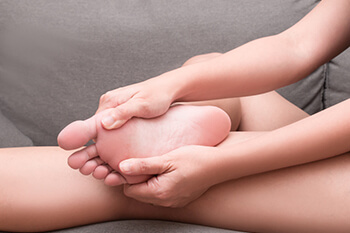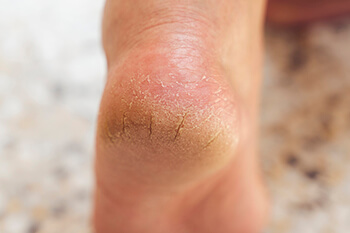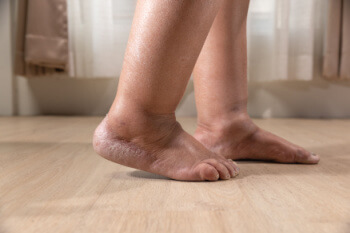Connect With Us
Blog

Ingrown toenails occur when the edge of the nail grows into the surrounding skin, causing pain, redness, swelling, and sometimes infection. This condition is common among teenagers and those who are overweight, as tight shoes or excess pressure can aggravate the toenails. In addition to discomfort, you may notice pus or drainage if an infection sets in. A podiatrist can help by assessing the severity of the ingrown toenail and providing treatment options. For mild cases, they may suggest soaking the foot, proper nail trimming techniques, or padding to reduce pressure. If the condition persists or becomes infected, a podiatrist may need to remove part of the nail, or, in more serious cases, perform a permanent nail removal procedure. They may also recommend wearing properly fitting shoes to prevent recurrence. If you are struggling with an ingrown toenail, it is suggested that you prompty schedule an appointment with a podiatrist who can offer effective treatment remedies.
Ingrown toenails may initially present themselves as a minor discomfort, but they may progress into an infection in the skin without proper treatment. For more information about ingrown toenails, contact Scott Samera, DPM of Samera / Foot + Ankle. Our doctor can provide the care you need to keep you pain-free and on your feet.
Ingrown Toenails
Ingrown toenails are caused when the corner or side of a toenail grows into the soft flesh surrounding it. They often result in redness, swelling, pain, and in some cases, infection. This condition typically affects the big toe and may recur if it is not treated properly.
Causes
- Improper toenail trimming
- Genetics
- Improper shoe fitting
- Injury from pedicures or nail picking
- Abnormal gait
- Poor hygiene
You are more likely to develop an ingrown toenail if you are obese, have diabetes, arthritis, or have any fungal infection in your nails. Additionally, people who have foot or toe deformities are at a higher risk of developing an ingrown toenail.
Symptoms
Some symptoms of ingrown toenails are redness, swelling, and pain. In rare cases, there may be a yellowish drainage coming from the nail.
Treatment
Ignoring an ingrown toenail can have serious complications. Infections of the nail border can progress to a deeper soft-tissue infection, which can then turn into a bone infection. You should always speak with your podiatrist if you suspect you have an ingrown toenail, especially if you have diabetes or poor circulation.
If you have any questions, please feel free to contact our office located in Lake City and Branford, FL . We offer the newest diagnostic and treatment technologies for all your foot care needs.

Achilles tendon injuries are a frequent concern for cyclists due to the repetitive motion and sustained force placed on the lower leg. The Achilles tendon connects the calf muscles to the heel bone, and excessive strain can lead to inflammation or degeneration. Poor bike fit, improper cleat placement, and muscle imbalances may increase the likelihood of an Achilles tendon injury, particularly when the heel or toes are forced into an unnatural position while pedaling. Symptoms include stiffness, swelling, and pain near the heel or along the tendon, which may worsen in the morning or after cycling. People with tight calf muscles or restricted ankle mobility may also be at higher risk, as limited flexibility can cause additional strain on the tendon. A podiatrist can evaluate your foot and ankle mechanics, recommend custom orthotics to improve alignment, and provide treatment to reduce pain and promote healing. Severe cases may require surgery to repair tendon damage. If you are experiencing Achilles tendon pain, it is suggested that you schedule an appointment with a podiatrist for a diagnosis and appropriate treatment options.
Achilles tendon injuries need immediate attention to avoid future complications. If you have any concerns, contact Scott Samera, DPM of Samera / Foot + Ankle. Our doctor can provide the care you need to keep you pain-free and on your feet.
What Is the Achilles Tendon?
The Achilles tendon is a tendon that connects the lower leg muscles and calf to the heel of the foot. It is the strongest tendon in the human body and is essential for making movement possible. Because this tendon is such an integral part of the body, any injuries to it can create immense difficulties and should immediately be presented to a doctor.
What Are the Symptoms of an Achilles Tendon Injury?
There are various types of injuries that can affect the Achilles tendon. The two most common injuries are Achilles tendinitis and ruptures of the tendon.
Achilles Tendinitis Symptoms
- Inflammation
- Dull to severe pain
- Increased blood flow to the tendon
- Thickening of the tendon
Rupture Symptoms
- Extreme pain and swelling in the foot
- Total immobility
Treatment and Prevention
Achilles tendon injuries are diagnosed by a thorough physical evaluation, which can include an MRI. Treatment involves rest, physical therapy, and in some cases, surgery. However, various preventative measures can be taken to avoid these injuries, such as:
- Thorough stretching of the tendon before and after exercise
- Strengthening exercises like calf raises, squats, leg curls, leg extensions, leg raises, lunges, and leg presses
If you have any questions please feel free to contact our office located in Lake City and Branford, FL . We offer the newest diagnostic tools and technology to treat your foot and ankle needs.

A bunion is not just a bump on the side of the foot. It is your foot’s way of protesting years of pressure, wearing poor footwear, or genetic predisposition. This bony misalignment at the base of the big toe develops gradually, often starting as mild discomfort before turning into persistent pain. Shoes that once fit perfectly start to feel tight, and walking can become a struggle. Beyond appearance, bunions can affect balance, alter gait, and lead to secondary problems like corns, calluses, and joint stiffness. While wider shoes, padding, and toe spacers can ease symptoms, they do not fix the underlying issue. Severe bunions may require corrective surgery to realign the toe and restore function. Ignoring the pain will not make it disappear. If a bunion is interfering with your daily life, it is suggested that you see a podiatrist for options to relieve discomfort and prevent further damage.
If you are suffering from bunion pain, contact Scott Samera, DPM of Samera / Foot + Ankle. Our doctor can provide the care you need to keep you pain-free and on your feet.
What Is a Bunion?
Bunions are painful bony bumps that usually develop on the inside of the foot at the joint of the big toe. As the deformity increases over time, it may become painful to walk and wear shoes. Women are more likely to exacerbate existing bunions since they often wear tight, narrow shoes that shift their toes together. Bunion pain can be relieved by wearing wider shoes with enough room for the toes.
Causes
- Genetics – some people inherit feet that are more prone to bunion development
- Inflammatory Conditions - rheumatoid arthritis and polio may cause bunion development
Symptoms
- Redness and inflammation
- Pain and tenderness
- Callus or corns on the bump
- Restricted motion in the big toe
In order to diagnose your bunion, your podiatrist may ask about your medical history, symptoms, and general health. Your doctor might also order an x-ray to take a closer look at your feet. Nonsurgical treatment options include orthotics, padding, icing, changes in footwear, and medication. If nonsurgical treatments don’t alleviate your bunion pain, surgery may be necessary.
If you have any questions, please feel free to contact our office located in Lake City and Branford, FL . We offer the newest diagnostic and treatment technologies for all your foot care needs.

Choosing the right running shoe is vital for comfort and performance. There are four main types of running shoes, each designed to address different needs. Motion control shoes are ideal for runners who overpronate, offering extra support to prevent excessive inward rolling of the foot. Stability shoes provide moderate support and cushioning, making them suitable for runners who need a balance between comfort and stability. Neutral shoes are designed for runners with a neutral stride, providing cushioning without added support, perfect for those with a natural gait. Lastly, minimalist shoes aim to mimic barefoot running by offering minimal cushioning and support, encouraging a more natural foot movement. Understanding your running style and foot mechanics is key to selecting the right shoe, as it can help improve performance and prevent injuries during your runs. If you have sustained a foot or ankle injury while running, it is suggested that you consult a podiatrist who can treat various foot conditions, and guide you on what type of running shoe to purchase.
If you are a runner, wearing the right running shoe is essential. For more information, contact Scott Samera, DPM from Samera / Foot + Ankle. Our doctor can provide the care you need to keep you pain-free and on your feet.
Choosing the Right Running Shoe for Your Foot Type
To increase performance and avoid the risk of injury, it is important to choose the right running shoe based on your foot type. The general design of running shoes revolves around pronation, which is how the ankle rolls from outside to inside when the foot strikes the ground.
- Neutral runners are able to choose from a wide variety of shoes, including minimalist shoes or even going barefoot.
- Runners who overpronate, or experience an over-abundance of ankle rolling, should choose shoes that provide extra motion control and stability.
- Runners who underpronate, or supinate, have feet that have high arches and lack flexibility, preventing shock absorption. They require shoes with more flexibility and cushion.
If you have any questions please feel free to contact our office located in Lake City and Branford, FL . We offer the newest diagnostic and treatment technologies for all your foot and ankle needs.

Sesamoiditis is named after the sesamoid bones, which are small, pea-shaped bones embedded in tendons beneath the big toe joint. These bones act like pulleys, aiding movement and bearing weight. Sesamoiditis occurs when these bones or surrounding tendons become inflamed, often due to repetitive stress or overuse. It is common among athletes, dancers, and individuals who engage in activities requiring frequent toe pressure, such as running or jumping. People with high arches or those who wear high heels are also at a higher risk. Symptoms include pain beneath the big toe, swelling, and difficulty bearing weight. Left untreated, it may lead to chronic discomfort or restricted mobility. If you have this type of foot pain, it is suggested that you schedule an appointment with a podiatrist who can provide an accurate diagnosis and offer treatments like orthotics, activity modification, or in severe cases, surgery. Early care helps alleviate pain and prevent further damage.
Sesamoiditis is an unpleasant foot condition characterized by pain in the balls of the feet. If you think you’re struggling with sesamoiditis, contact Scott Samera, DPM of Samera / Foot + Ankle. Our doctor will treat your condition thoroughly and effectively.
Sesamoiditis
Sesamoiditis is a condition of the foot that affects the ball of the foot. It is more common in younger people than it is in older people. It can also occur with people who have begun a new exercise program, since their bodies are adjusting to the new physical regimen. Pain may also be caused by the inflammation of tendons surrounding the bones. It is important to seek treatment in its early stages because if you ignore the pain, this condition can lead to more serious problems such as severe irritation and bone fractures.
Causes of Sesamoiditis
- Sudden increase in activity
- Increase in physically strenuous movement without a proper warm up or build up
- Foot structure: those who have smaller, bonier feet or those with a high arch may be more susceptible
Treatment for sesamoiditis is non-invasive and simple. Doctors may recommend a strict rest period where the patient forgoes most physical activity. This will help give the patient time to heal their feet through limited activity. For serious cases, it is best to speak with your doctor to determine a treatment option that will help your specific needs.
If you have any questions please feel free to contact our office located in Lake City and Branford, FL . We offer the newest diagnostic and treatment technologies for all your foot and ankle needs.

Cracked heels, also known as heel fissures, are a common foot condition where the skin on the heels becomes dry, thickened, and cracked. This condition often causes pain and discomfort, especially when walking or standing for long periods. The main symptoms include visible cracks in the skin, redness, and in severe cases, bleeding or infection. Cracked heels are primarily caused by dryness, which can occur due to exposure to cold weather, hot showers, or standing for long periods of time. Other contributing factors include wearing open-back shoes, obesity, or having certain medical conditions such as diabetes or eczema. Risk factors also include inadequate foot care, using harsh soaps, and being on your feet for long durations. To prevent cracked heels, it is important to moisturize regularly, wear proper footwear, and avoid long exposure to dry conditions. If cracks are deep or painful, it is suggested that you consult a podiatrist who can prescribe medication for relief and other effective treatment.
Cracked heels are unsightly and can cause further damage to your shoes and feet. If you have any concerns, contact Scott Samera, DPM from Samera / Foot + Ankle. Our doctor can provide the care you need to keep you pain-free and on your feet.
Cracked Heels
Cracked heels appear unappealing and can make it harder for you walk around in sandals. Aside from looking unpleasant, cracked heels can also tear stockings, socks, and wear out your shoes. There are several methods to help restore a cracked heel and prevent further damage.
How Do You Get Them?
Dry skin is the number one culprit in creating cracked heels. Many athletes, walkers, joggers, and even swimmers suffer from cracked heels. Age and skin oil production play a role to getting cracked heels as well.
Promote Healing
Over the counter medicines can help, especially for those that need instant relief or who suffer from chronic dry feet.
Wear Socks – Wearing socks with medicated creams helps lock in moisture.
Moisturizers – Applying both day and night will help alleviate dryness which causes cracking.
Pumice Stones – These exfoliate and remove dead skin, which allows for smoother moisturizer application and better absorption into the skin.
Change in Diet
Eating healthy with a well-balanced diet will give the skin a fresh and radiant look. Your body responds to the kinds of food you ingest. Omega-3 fatty acids and zinc supplements can also revitalize skin tissue.
Most importantly, seek professional help if unsure how to proceed in treating cracked heels. A podiatrist will help you with any questions or information needed.
If you have any questions, please feel free to contact our office located in Lake City and Branford, FL . We offer the newest diagnostic and treatment technologies for all your foot care needs.

Swollen feet can be caused by several factors, often linked to underlying health conditions. One common cause is leaky veins, where blood flows backward due to weakened valves, leading to fluid buildup in the lower limbs. This condition, known as venous insufficiency, is often accompanied by discomfort and swelling. Another factor to consider is the side effects of medication. Certain drugs, such as those used for high blood pressure or diabetes, can cause fluid retention, leading to swelling in the feet. Dependent edema is another possible cause, particularly for individuals who spend prolonged periods standing or sitting. This condition results from gravity pulling fluid into the lower extremities. Lastly, inflammation due to injury, infection, or conditions like arthritis can cause swelling in the feet. If you have swollen feet, it is suggested that you consult a podiatrist who can determine what the reason is, and offer effective relief and treatment tips.
Swollen feet can be a sign of an underlying condition. If you have any concerns, contact Scott Samera, DPM of Samera / Foot + Ankle. Our doctor can provide the care you need to keep you pain-free and on your feet.
Swollen feet are a common ailment among pregnant women and people who stand or sit for extended periods. Aging may increase the possibility of swollen feet and patients who are obese often notice when their feet are swelling too. There may be medical reasons why swollen feet occur:
- Phlebitis - A condition that causes the veins to become inflamed and can also cause leg pain.
- Liver disease - This may lead to low blood levels of albumin which is a protein. This can cause fluid in the blood to pass into the tissues and several areas of the body can become swollen.
- Heart failure - When the heart doesn’t pump properly the blood that is normally pumped back to the heart can pool in the veins of the legs causing swollen feet.
- Kidney disease - One of the main functions of the kidneys is releasing excess fluid in the body. This type of condition can make it difficult for the kidneys to function properly, and as a result the feet may become swollen.
- Deep-vein thrombosis (DVT)- This is a serious condition where blood clots form in the veins of the legs. They can block the return of blood from the legs to the heart which may cause the feet to swell. It is important to be treated by a podiatrist if this condition is present.
Swollen feet can also be caused by bone and tendon conditions, including fractures, arthritis, and tendinitis. Additionally, there may be skin and toenail conditions and an infection may cause the feet to swell. Patients who take medicine to treat high blood pressure may be prone to getting swollen feet.
Many patients elevate their feet to help relieve the swelling and this is generally a temporary remedy. When a podiatrist is consulted the reason behind the swelling can be uncovered and subsequently treated.
If you have any questions please feel free to contact our office located in Lake City and Branford, FL . We offer the newest diagnostic tools and technology to treat your foot and ankle needs.

Treadmill running can contribute to foot, toe, and ankle injuries due to repetitive stress and strain. Common issues include plantar fasciitis, intermetatarsal neuromas, and Achilles tendonitis. These ailments are often caused by the repetitive motions of running or walking, especially on an incline. They may result in pain in the arch, ball of the foot, or along the back of the ankle. Improper footwear, excessive treadmill use, or pre-existing conditions like tight calf muscles can increase the risk of injury. A podiatrist can assess these conditions through a detailed examination and advanced diagnostic tools. This foot doctor can recommend effective treatments, such as orthotics, adjustments to treadmill routines, or specific footwear advice, to alleviate pain and prevent further issues. If you experience foot pain related to treadmill running, it is suggested that you schedule an appointment with a podiatrist for a diagnosis and treatment options.
Exercising your feet regularly with the proper foot wear is a great way to prevent injuries and build strength. If you have any concerns about your feet, contact Scott Samera, DPM from Samera / Foot + Ankle. Our doctor can provide the care you need to keep you pain-free and on your feet.
Exercise for Your Feet
Exercise for your feet can help you gain strength, mobility and flexibility in your feet. They say that strengthening your feet can be just as rewarding as strengthening another part of the body. Your feet are very important, and we often forget about them in our daily tasks. But it is because of our feet that are we able to get going and do what we need to. For those of us fortunate enough to not have any foot problems, it is an important gesture to take care of them to ensure good health in the long run.
Some foot health exercises can include ankle pumps, tip-toeing, toe rises, lifting off the floor doing reps and sets, and flexing the toes. It is best to speak with Our doctor to determine an appropriate regimen for your needs. Everyone’s needs and bodies are different, and the activities required to maintain strength in the feet vary from individual to individual.
Once you get into a routine of doing regular exercise, you may notice a difference in your feet and how strong they may become.
If you have any questions please feel free to contact our office located in Lake City and Branford, FL . We offer the newest diagnostic and treatment technologies for all your foot and ankle needs.
Blog Archives
- 2025
- 2024
- 2023
- 2022






